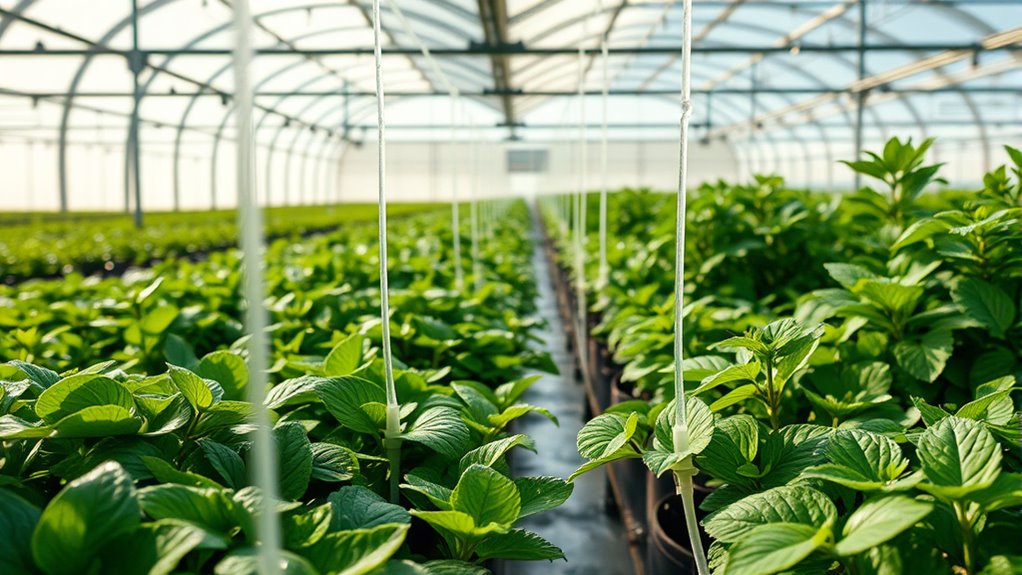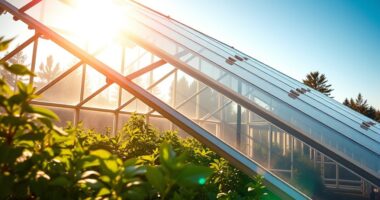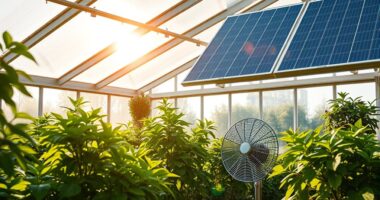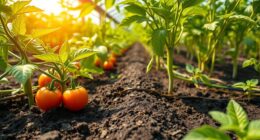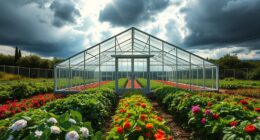To conserve water efficiently in your greenhouse, consider using rainwater harvesting to collect free, natural water and store it for later use. Combine this with drip irrigation systems that deliver water directly to plant roots, minimizing evaporation and runoff. This approach helps you maintain healthy plants while reducing water waste and costs. Keep exploring ways to optimize your watering techniques for an eco-friendly, cost-effective greenhouse operation.
Key Takeaways
- Implement rainwater harvesting to collect and store natural water sources for greenhouse use.
- Use drip irrigation systems to deliver targeted watering, minimizing runoff and evaporation.
- Combine rainwater with drip irrigation for a sustainable, eco-friendly watering approach.
- Control watering precisely to prevent overwatering, root rot, and water wastage.
- Select low-light tolerant plants to optimize water use efficiency in greenhouse environments.

Have you ever considered how much water you use daily and the impact it has on our planet? If you’re managing a greenhouse, this awareness becomes even more essential. Greenhouses require consistent watering to keep plants healthy, but using water efficiently can make a significant difference. One effective method is rainwater harvesting, which involves collecting rainwater from rooftops or other surfaces and storing it for later use. Instead of relying solely on municipal water supplies, you can set up a system to channel rainwater into barrels or underground tanks. This approach not only conserves fresh water but also reduces your water bills. Plus, rainwater is often softer and free of chemicals found in tap water, making it beneficial for many plants.
Once you’ve gathered rainwater, the next step is to deliver it efficiently to your plants. That’s where drip irrigation comes into play. Drip irrigation systems are designed to deliver water directly to the roots of your plants, minimizing wastage from runoff or evaporation. You can install drip emitters at each plant’s base, ensuring a steady, slow release of water exactly where it’s needed. This targeted approach helps maintain ideal soil moisture levels, encouraging healthy growth and reducing water consumption overall. Combining rainwater harvesting with drip irrigation creates a sustainable watering system that’s both eco-friendly and cost-effective.
Implementing rainwater harvesting and drip irrigation also reduces the risk of overwatering or underwatering. With precise control over water delivery, you’re less likely to waste water or cause root rot. It’s especially useful in climates with unpredictable rainfall, as stored rainwater can supplement your regular watering schedule during dry spells. Additionally, these techniques lessen the strain on local water supplies, helping to conserve this essential resource for future generations. They also promote healthier plants, since rainwater often contains fewer chemicals and salts compared to tap water. Using a low-light tolerant plant selection can further optimize water use, as these plants typically require less frequent watering and thrive in shaded greenhouse environments.
Frequently Asked Questions
How Can I Monitor Soil Moisture Levels Effectively?
You can monitor soil moisture levels effectively by using soil probes or moisture sensors. Insert soil probes into different areas of your greenhouse to get quick readings, or install electronic moisture sensors that provide real-time data. Regularly check these devices to guarantee ideal watering. By keeping an eye on these readings, you’ll prevent overwatering or underwatering, promoting healthy plant growth and conserving water efficiently.
What Are the Best Times of Day to Water?
Think of watering schedules like a well-timed telegram—precision matters. You should water early in the morning or late in the afternoon, when temperatures are cooler. This ideal timing minimizes evaporation and ensures plants absorb more water. Avoid midday watering, especially during the hottest hours, to prevent stress and water waste. By sticking to these times, you’ll keep your greenhouse thriving while conserving water effectively.
How Does Greenhouse Humidity Affect Watering Needs?
Greenhouse humidity considerably influences your watering requirements through humidity regulation and vapor pressure. When humidity is high, plants lose less water, reducing your watering frequency. Conversely, low humidity increases vapor pressure deficit, causing plants to transpire more and need more water. Monitoring humidity levels closely helps you adjust watering schedules effectively, preventing over- or under-watering. Maintaining ideal humidity ensures healthier plants and conserves water efficiently.
Can Automated Systems Improve Watering Efficiency?
You might think automated systems are costly, but they notably boost watering efficiency. By integrating drip irrigation with rainwater harvesting, you ensure precise water delivery, reducing waste and saving money. Automated timers and sensors adjust watering based on humidity and soil moisture, preventing over- or under-watering. This technology simplifies your greenhouse management, conserves water, and promotes healthier plants, making automation a smart, eco-friendly investment you can’t afford to overlook.
What Are Eco-Friendly Water Sources for Greenhouses?
You can use eco-friendly water sources like rainwater harvesting and greywater recycling for your greenhouse. Rainwater harvesting captures rainwater, reducing reliance on municipal water, while greywater recycling reuses water from sinks or washing machines, lowering overall consumption. Both methods help conserve water, reduce costs, and promote sustainability, making your greenhouse more environmentally friendly. Implementing these practices guarantees you use natural resources efficiently and diminish your ecological footprint.
Conclusion
By adopting efficient watering techniques, you conserve water, enhance plant health, and reduce waste. You prioritize precision, practice consistency, and promote sustainability. You monitor moisture levels, adjust watering schedules, and use innovative tools. In doing so, you create a resilient greenhouse environment, support eco-friendly practices, and guarantee long-term success. Water conservation isn’t just a task—it’s a commitment, a responsibility, and a crucial step toward a greener future for your greenhouse and the planet.
